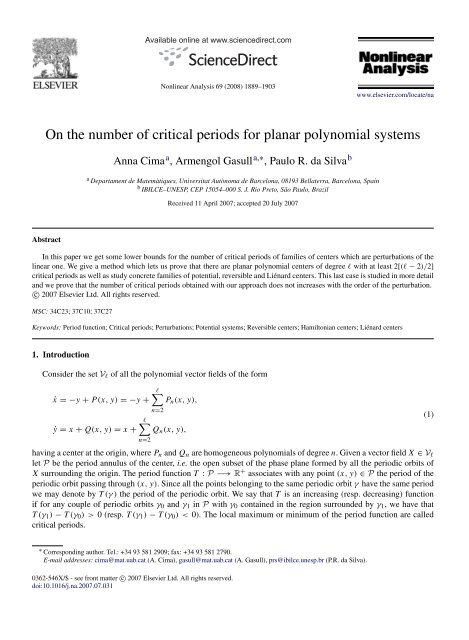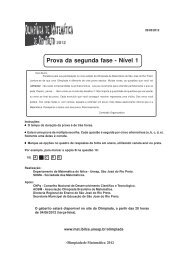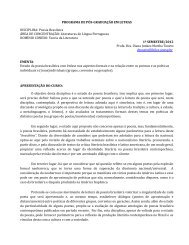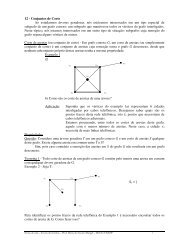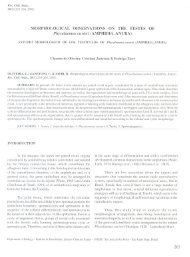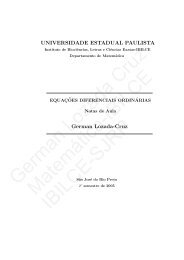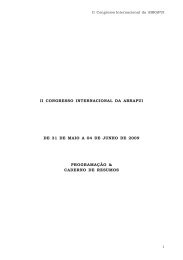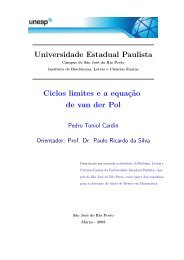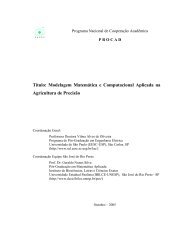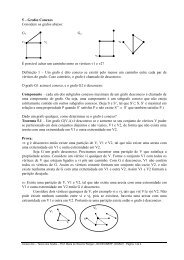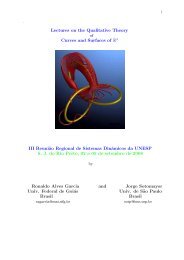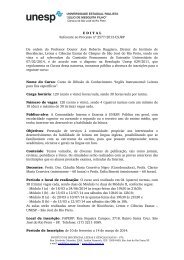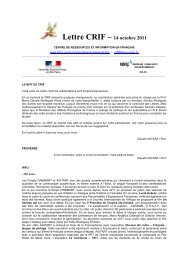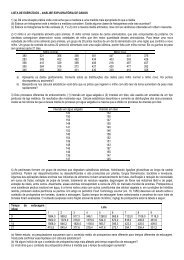On the number of critical periods for planar polynomial ... - Unesp
On the number of critical periods for planar polynomial ... - Unesp
On the number of critical periods for planar polynomial ... - Unesp
You also want an ePaper? Increase the reach of your titles
YUMPU automatically turns print PDFs into web optimized ePapers that Google loves.
Nonlinear Analysis 69 (2008) 1889–1903www.elsevier.com/locate/na<strong>On</strong> <strong>the</strong> <strong>number</strong> <strong>of</strong> <strong>critical</strong> <strong>periods</strong> <strong>for</strong> <strong>planar</strong> <strong>polynomial</strong> systemsAnna Cima a , Armengol Gasull a,∗ , Paulo R. da Silva ba Departament de Matemàtiques, Universitat Autònoma de Barcelona, 08193 Bellaterra, Barcelona, Spainb IBILCE–UNESP, CEP 15054–000 S. J. Rio Preto, São Paulo, BrazilReceived 11 April 2007; accepted 20 July 2007AbstractIn this paper we get some lower bounds <strong>for</strong> <strong>the</strong> <strong>number</strong> <strong>of</strong> <strong>critical</strong> <strong>periods</strong> <strong>of</strong> families <strong>of</strong> centers which are perturbations <strong>of</strong> <strong>the</strong>linear one. We give a method which lets us prove that <strong>the</strong>re are <strong>planar</strong> <strong>polynomial</strong> centers <strong>of</strong> degree l with at least 2[(l − 2)/2]<strong>critical</strong> <strong>periods</strong> as well as study concrete families <strong>of</strong> potential, reversible and Liénard centers. This last case is studied in more detailand we prove that <strong>the</strong> <strong>number</strong> <strong>of</strong> <strong>critical</strong> <strong>periods</strong> obtained with our approach does not increases with <strong>the</strong> order <strong>of</strong> <strong>the</strong> perturbation.c○ 2007 Elsevier Ltd. All rights reserved.MSC: 34C23; 37C10; 37C27Keywords: Period function; Critical <strong>periods</strong>; Perturbations; Potential systems; Reversible centers; Hamiltonian centers; Liénard centers1. IntroductionConsider <strong>the</strong> set V l <strong>of</strong> all <strong>the</strong> <strong>polynomial</strong> vector fields <strong>of</strong> <strong>the</strong> <strong>for</strong>ml∑ẋ = −y + P(x, y) = −y + P n (x, y),n=2l∑ẏ = x + Q(x, y) = x + Q n (x, y),n=2(1)having a center at <strong>the</strong> origin, where P n and Q n are homogeneous <strong>polynomial</strong>s <strong>of</strong> degree n. Given a vector field X ∈ V llet P be <strong>the</strong> period annulus <strong>of</strong> <strong>the</strong> center, i.e. <strong>the</strong> open subset <strong>of</strong> <strong>the</strong> phase plane <strong>for</strong>med by all <strong>the</strong> periodic orbits <strong>of</strong>X surrounding <strong>the</strong> origin. The period function T : P −→ R + associates with any point (x, y) ∈ P <strong>the</strong> period <strong>of</strong> <strong>the</strong>periodic orbit passing through (x, y). Since all <strong>the</strong> points belonging to <strong>the</strong> same periodic orbit γ have <strong>the</strong> same periodwe may denote by T (γ ) <strong>the</strong> period <strong>of</strong> <strong>the</strong> periodic orbit. We say that T is an increasing (resp. decreasing) functionif <strong>for</strong> any couple <strong>of</strong> periodic orbits γ 0 and γ 1 in P with γ 0 contained in <strong>the</strong> region surrounded by γ 1 , we have thatT (γ 1 ) − T (γ 0 ) > 0 (resp. T (γ 1 ) − T (γ 0 ) < 0). The local maximum or minimum <strong>of</strong> <strong>the</strong> period function are called<strong>critical</strong> <strong>periods</strong>.∗ Corresponding author. Tel.: +34 93 581 2909; fax: +34 93 581 2790.E-mail addresses: cima@mat.uab.cat (A. Cima), gasull@mat.uab.cat (A. Gasull), prs@ibilce.unesp.br (P.R. da Silva).0362-546X/$ - see front matter c○ 2007 Elsevier Ltd. All rights reserved.doi:10.1016/j.na.2007.07.031
1892 A. Cima et al. / Nonlinear Analysis 69 (2008) 1889–1903Table 1Values <strong>of</strong> N l k (pot)k/l 2 3 4 5 6 7 81 0 0 0 1 1 2 22 0 0 2 2 4 4 63 0 0 1 1 2 3 44 0 1 2 2 4 5 65 0 0 1 1 3 3 46 0 0 2 2 4 4 67 0 0 2 2 3 – –8 0 1 – ≥3 – – –Proposition 3. With <strong>the</strong> above notation,[ ] l − 3N1 l = N 1 l (Ham) = N 1 l (rev) = N 1 l (pot) = ,2[ ] l − 2N2 l ≥ N 2 l (Ham) ≥ N 2 l (pot) = 2 .2Notice that from <strong>the</strong> previous results it follows that N 3 > N 3 2 (pot).Proposition 4. The <strong>number</strong>s Nk l (pot) <strong>for</strong> k ≤ 8 and l ≤ 8 are given in Table 1.We make some comments about <strong>the</strong> results <strong>of</strong> Table 1:– The results <strong>of</strong> <strong>the</strong> first two columns are not surprising because, as we have already said, it is proved in [5] thatN 2 (pot) = 0 and in [11] that N 3 (pot) = 1.– The results <strong>of</strong> our study give <strong>for</strong> <strong>the</strong> <strong>number</strong>s N 4 (pot) and N 5 (pot) <strong>the</strong> same lower bounds as are obtained in [5]by studying <strong>the</strong> period constants at <strong>the</strong> origin, namely 2 and 3, respectively.– The easiest open problem suggested by <strong>the</strong> above table is that <strong>of</strong> whe<strong>the</strong>r N 4 (pot) is 2 or greater.– The empty places in <strong>the</strong> last two rows correspond to values <strong>of</strong> k and l <strong>for</strong> which we have not been able to completeall <strong>the</strong> computations involved.The pro<strong>of</strong> <strong>of</strong> Proposition 3, as well as some examples showing that N8 5(pot) ≥ 3 and N 4 7 (pot) ≥ 5, are given inSection 4.Liénard centers are studied in Section 5. Recall that N 2 (Lie) = 0, see [2]. We prove <strong>the</strong> following result:Theorem 5. Fix l even. The following hold:(i) For any j ∈ N, N2 l j−1 (Lie) = 0 and N 2 l j (Lie) = N 2 l (Lie) ≤ l − 2.(ii) For l = 2, 4, 6 and 8 we have that N2 l (Lie) = l − 2.Note that <strong>the</strong> above results say that <strong>the</strong> maximum <strong>number</strong> <strong>of</strong> <strong>critical</strong> <strong>periods</strong> obtained by using our method doesnot increase when more T j (ρ) are considered. For instance this does not happen when we study potential systems;see Table 1. This property makes it natural to wonder whe<strong>the</strong>r N2 l(Lie) is or is not equal to N l (Lie), as happens <strong>for</strong>l = 2. Notice also that a pro<strong>of</strong> that N2 l (Lie) = l − 2 would give a new pro<strong>of</strong> <strong>of</strong> Theorem 1 in <strong>the</strong> case l even.Finally, reversible centers are studied in Section 6. In particular we have studied <strong>the</strong> case l = 2 and <strong>the</strong> maximum<strong>number</strong> <strong>of</strong> <strong>critical</strong> <strong>periods</strong> that we have found is 2, giving new support to <strong>the</strong> conjecture stated in [3] that N 2 (rev) = 2.2. Pro<strong>of</strong> <strong>of</strong> Theorem 2In this section we prove Theorem 2. (a) For <strong>the</strong> sake <strong>of</strong> simplicity, we only give <strong>the</strong> details <strong>for</strong> <strong>the</strong> computation <strong>of</strong>T k (ρ), k = 1, 2, 3. The T k (ρ) <strong>for</strong> k ≥ 4 can be obtained similarly. We start by finding <strong>the</strong> first terms <strong>of</strong> <strong>the</strong> solution
A. Cima et al. / Nonlinear Analysis 69 (2008) 1889–1903 1893r(θ, ε; ρ) = ∑ ∞i=0 r i (θ; ρ)ε i <strong>of</strong> (4) with <strong>the</strong> initial condition r(0, ε) = ρ. By replacing this expression in (4) weobtain thatr 0 (θ) ≡ ρ, r 1 (θ; ρ) =r 2 (θ; ρ) =∫ θNote that <strong>for</strong> any k ≥ 1,0∫ θ0A 1 (ρ, ψ)dψ,(A 2 (ρ, ψ) − A 1 (ρ, ψ)B 1 (ρ, ψ) + ∂ A )1∂r (ρ, ψ)r 1(ψ; ρ) dψ.B k (r(θ, ε; ρ), θ) = B k (ρ, θ) + ∂ B k∂r (ρ, θ)r 1(θ; ρ)ε + O(ε 2 )and that1∣1 + B 1 (r, θ)ε + B 2 (r, θ)ε 2 + B 3 (r, θ)ε 3 + O(ε 4 )= 1 + (−B 1 (r, θ))ε + (−B 2 (r, θ) + B1 2 (r, θ))ε2∣r=r(θ,ε;ρ)+ (−B 3 (r, θ) + 2B 1 (r, θ)B 2 (r, θ) − B1 3 (r, θ))ε3 + O(ε 4 )| r=r(θ,ε;ρ)(= 1 − εB 1 (ρ, θ) + ε 2 B1 2 (ρ, θ) − B 2(ρ, θ) − ∂ B )1(ρ, θ)r 1 (θ; ρ)∂r(+ ε 3 − ∂ B 1(ρ, θ)r 2 (θ; ρ) − ∂ B 2(ρ, θ)r 1 (θ; ρ) − 1 ∂ 2 B 1 (ρ, θ)∂r∂r2 ∂r 2 r1 2 (θ; ρ))∂ B 1 (ρ, θ)+ 2B 1 r 1 (θ; ρ) − B 3 (ρ, θ) +2B 1 (ρ, θ)B 2 (ρ, θ) − B1 3 ∂r(ρ, θ) + O(ε 4 ).From (3) we know that∫ 2π ∫dθ 2πT (ρ, ε) =0˙θ = 10 1 + B 1 (r, θ)ε + B 2 (r, θ)ε 2 + · · · ∣ dθr=r(θ,ε;ρ)∫ 2π∫ 2π(= 2π − ε B 1 (ρ, θ)dθ + ε 2 B1 2 (ρ, θ) − B 2(ρ, θ) − ∂ B )1(ρ, θ)r 1 (θ; ρ) dθ00∂r∫ 2π(+ ε 3 − ∂ B 1(ρ, θ)r 2 (θ; ρ) − ∂ B 2(ρ, θ)r 1 (θ; ρ) − 1 ∂ 2 B 1 (ρ, θ)0 ∂r∂r2 ∂r 2 r1 2 (θ; ρ))∂ B 1 (ρ, θ)+ 2B 1 r 1 (θ; ρ) −B 3 (ρ, θ) + 2B 1 (ρ, θ)B 2 (ρ, θ) − B1 3 ∂r(ρ, θ) dθ + O(ε 4 ),as we wanted to prove.(b) The result follows by applying <strong>the</strong> implicit function <strong>the</strong>orem to <strong>the</strong> equation0 = 1 ε k ∂T (ρ, ε)∂ρ= T k ′ (ρ) + O(ε). □3. Pro<strong>of</strong> <strong>of</strong> Theorem 1It is clear that Theorem 1 is a consequence <strong>of</strong> Proposition 3. We prove this in <strong>the</strong> sequel.Pro<strong>of</strong> <strong>of</strong> Proposition 3. We start by proving that N1lεP(x, y), ẏ = x + εQ(x, y). ThusT 1 (ρ) = −∫ 2π0B 1 (ρ, θ)dθ = −∫ 2π0≤ [l−32]. Take any center in V l <strong>of</strong> <strong>the</strong> <strong>for</strong>m ẋ = −y +∣x Q(x, y) − y P(x, y) ∣∣∣(x,y)=(ρρ 2dθ.cos θ,ρ sin θ)
andMoreover∫ 2π0B 2 (ρ, ψ)dψ =l∑(j=2A. Cima et al. / Nonlinear Analysis 69 (2008) 1889–1903 1895b 2 j−1The integrals ∫ 2π0B1 2dθ and ∫ 2π0l∑n=2n=2)(2 j)!4 j ( j!) 2 2π ρ 2 j−2 .( )∑n−1(2n + 1)!2πa 2m a 2n−2m(2n + 2)4m=1 n (n!) 2 ρ 2n−2∂ B 1∂r r 1dθ are given respectively by(l∑ ∑n−1() ) (2n + 1)!2πa 2m a 2n−2m (2n − 2m − 1) −(2m + 1)(2n + 2)4m=1n (n!) 2 ρ 2n−2 .Collecting all <strong>the</strong> above results, by using Theorem 2, we get that T 1 = 0 and <strong>the</strong> expression (7) <strong>for</strong> T 2 . Take k suchthat l = 2k or l = 2k + 1. In order to see that N2 l(pot) ≤ 2k − 2 we observe that T 2(ρ) is an even <strong>polynomial</strong> withouta constant term and we claim that its degree is 4k −2. If l = 2k, <strong>the</strong>n 2l−2 = 4k −2. If l = 2k +1, <strong>the</strong>n 2l−2 = 4k,but <strong>the</strong> coefficient <strong>of</strong> ρ 4k is zero. This is so because b 4k+1 = 0 (b i runs from i = 2 until 2k + 1) and a 2m a 2l−2m = 0<strong>for</strong> all m = 1, 2, . . . , l − 1 (a 2i takes <strong>the</strong> values a 2 until a 2k ). Hence, T2 ′ (ρ) has at most 2k − 2 positive zeros and wehave that N2 l (pot) ≤ 2k − 2.To prove that <strong>the</strong> equality holds we need to choose <strong>the</strong> values a 2 , a 4 , . . . , a 2k and b 3 , b 5 , . . . , b 2k−1 such that T2 ′(ρ)has arbitrary coefficients. Indeed this will be a consequence <strong>of</strong> <strong>the</strong> following <strong>for</strong>mula, which shows a kind <strong>of</strong> triangularstructure <strong>for</strong> <strong>the</strong> coefficients <strong>of</strong> <strong>the</strong> <strong>polynomial</strong>:T 2 (ρ) = −k∑{J 2 (n)b 2n−1 + f n (a 2 , a 4 , . . . , a 2k )} ρ 2n−2n=2{ (−1) l − 1+2+2k−1 ∑n=k+2}J 2 (k + 1)b 2k+1 + [J 1 (2, 2k) + J 1 (2k, 2)] a 2 a 2k + f k+1 (a 4 , a 6 , . . . , a 2k ) ρ 2k{[J 1 (2n − 2k, 2k) + J 1 (2k, 2n − 2k)] a 2n−2k a 2k+ f n (a 2n−2k+2 , a 2n−2k+4 , . . . , a 2k )} ρ 2n−2 + J 1 (2k, 2k)a 2 2k ρ4k−2 .Here <strong>the</strong> functions f n are <strong>polynomial</strong>s in <strong>the</strong>ir variables. Write T 2 (ρ) = ∑ 2k−1i=1 t 2iρ 2i . Consider a new <strong>polynomial</strong>τ(ρ) = ∑ 2k−1i=1 τ 2iρ 2i with τ 4k−2 positive and such that τ ′ (ρ) has 2k − 2 simple positive roots. Let us see how tochoose a 2 , a 4 , . . . , a 2k and b 3 , b 5 , . . . , b 2k−1 such that T 2 (ρ) = τ(ρ). We start by fixing a 2k such that t 4k−2 = τ 4k−2 .Notice that this is possible <strong>for</strong> <strong>the</strong> triangular structure <strong>of</strong> <strong>the</strong> <strong>for</strong>mula <strong>for</strong> <strong>the</strong> coefficient <strong>of</strong> ρ 4k−4 . We can continuewith <strong>the</strong> same procedure until we obtain t 2k . At this point we have fixed a 2k , a 2k−2 , . . . , a 4 , a 2 and b 2k+1 (if it exists).The rest <strong>of</strong> <strong>the</strong> coefficients can be easily obtained by choosing b 2k−1 , b 2k−3 , . . . , b 3 . □4. Potential systemsIn this section we give some details about <strong>the</strong> pro<strong>of</strong> <strong>of</strong> Proposition 4. To obtain <strong>the</strong> results given in Table 1 weapply <strong>the</strong> method developed in Theorem 2 to potential centers. For <strong>the</strong> sake <strong>of</strong> brevity we omit <strong>the</strong> statement <strong>of</strong> <strong>the</strong>result <strong>for</strong> k = 7. The lower bound <strong>for</strong> two representative examples, N4 7(pot) and N 8 5 (pot), is given in more detail at<strong>the</strong> end <strong>of</strong> <strong>the</strong> section.The following five sets <strong>of</strong> conditions, depending on <strong>the</strong> coefficients appearing in (8): a 2 , . . . , a 8 , b 2 , . . . , b 8 ,c 2 , . . . , c 8 , d 2 , . . . , d 8 , w 2 , . . . , w 8 , will be used in our analysis.(C1) a 3 = a 5 = a 7 = 0.(C2) a 6 = a 8(= 0, b 3 = 10 9 a2 2 , b 5)= 14 5 a 2a 4 , b 7 = 3625 a2 4 .(C3) c 7 =3564 6340a 4 b 4 + 15 8 a 2b 6 , c 5 = 8 ( 745a 4 b 2 + 7 4 a )2b 4 , c3 = 209 a 2b 2 .
A. Cima et al. / Nonlinear Analysis 69 (2008) 1889–1903 1897T 4,6 = 6340 a 4c 4 + 15 8 b 2b 6 − 3564 d 7 + 6380 b2 4 − 25936 a3 2 a 4 + 15 8 a 2c 6 ,T 4,8 = 9964 b 4b 6 + 385192 a 2c 8 − 100180 a2 2 a2 4 + 9964 a 4c 6 + 385192 b 2b 8 ,T 4,9 = 1172 a 2(35a 2 b 8 + 27a 4 b 6 ),T 4,10 = 1001640 a 4c 8 −T 4,11 = 11320 a 4(72a 4 b 6 + 245a 2 b 8 ),T 4,12 = 715512 b 6b 8 −69 0698000 a 2a 3 4 + 12871792 b2 6 + 1001640 b 4b 8 ,33 03316 000 a4 4 , T 4,13 = 1001320 a2 4 b 8, T 4,14 =12 15518 432 b2 8 .(e) If <strong>the</strong> coefficient values satisfy conditions (C1)–(C4) <strong>the</strong>n T 1 ≡ T 2 ≡ T 3 ≡ 0, T 4 (ρ) = π 385192 a 2c 8 ρ 8 andT 5 (ρ) = π ∑ 10l=1 T 5,lρ l with T 5,1 = T 5,3 = T 5,5 = T 5,7 = 0 andT 5,2 = 5 3 a 2d 2 − 3 4 w 3 + 5 3 b 2c 2 ,T 5,4 = − 5 8 w 5 + 7 4 b 2c 4 + 7 4 a 2d 4 − 14027 a3 2 b 2 + 7 4 b 4c 2 ,T 5,6 = 6340 b 4c 4 + 15 8 a 2d 6 − 3564 w 7 − 25936 a3 2 b 4 + 15 8 b 2c 6 ,T 5,8 = 9964 b 4c 6 + 385192 a 2d 8 + 385192 b 2c 8 ,T 5,9 = 38572 a2 2 c 8, T 5,10 = 1001640 b 4c 8 .(f) If <strong>the</strong> coefficient values satisfy conditions (C1)–(C5) <strong>the</strong>n T 1 ≡ T 2 ≡ T 3 ≡ 0, T 4 (ρ) = π 385192 a 2c 8 ρ 8 ,∑T 5 (ρ) = π[T 5,8 ρ 8 + T 5,9 ρ 9 + T 5,10 ρ 10 14] and T 6 (ρ) = π T 6,l ρ lwith T 6,1 = T 6,3 = T 6,5 = T 6,7 = T 6,13 = 0 andT 6,2 = 5 6 c2 2 − 3 4 v 3 + 5 3 a 2w 2 + 5 3 b 2d 2 ,T 6,4 = − 5 8 v 5 + 7 4 a 2w 4 + 7 4 c 2c 4 − 14027 a3 2 c 2 + 7 4 b 4d 2 − 709 a2 2 b2 2 + 7 4 b 2d 4 ,T 6,6 = 6340 b 4d 4 + 15 8 c 2c 6 − 3564 v 7 + 6380 c2 4 − 25936 a3 2 c 4 + 158 a 2w 6 + 1855324 a6 2 − 25912 a2 2 b 2b 4 + 158 b 2d 6 ,T 6,8 = 9964 b 4d 6 + 385192 a 2w 8 − 100180 a2 2 b2 4 + 9964 c 4c 6 + 385192 c 2c 8 − 16516 a3 2 c 6 + 385192 b 2d 8 ,T 6,9 = 1172 a 2(35a 2 d 8 + 27b 4 c 6 + 70b 2 c 8 ),T 6,10 = 1001640 c 4c 8 + 12871792 c2 6 + 1001640 b 4d 8 +38 8853456 a3 2 c 8,T 6,11 = 59364 a 2b 4 c 8 , T 6,12 = 715512 c 6c 8 , T 6,14 =l=112 15518 432 c2 8 .An example showing that N 7 4(pot) ≥ 5: Consider a system like in Proposition 6 satisfying conditions (C1)–(C3),a 4 = 1, b 6 = 0 and, <strong>of</strong> course, b 8 = c 8 = d 8 = w 8 = v 8 = y 8 = z 8 = 0. For this choice <strong>of</strong> parameters we have thatT 1 = T 2 = T 3 = 0 and
ThenwhereT 1 (ρ) ≡ 0 and T 2 (ρ) =A. Cima et al. / Nonlinear Analysis 69 (2008) 1889–1903 18992k∑n=2( )∑n−1a 2m a 2n−2m I (n, m) ρ 2n−2m=1I (n, m) = 2(n − 2m + 2n2 − 2nm)(2n)!4 n π, (11)(n + 1)(2n − 2m + 1)(n!) 2and a j = 0 <strong>for</strong> j 2k + 2.Pro<strong>of</strong>. These systems are given in polar coordinates bywithWe haveṙ = ε A 1 (r, θ) + ε 2 A 2 (r, θ), ˙θ = 1 + εB 1 (r, θ) + ε 2 B 2 (r, θ)A 1 =k∑a 2m r 2m cos 2m+1 θ, A 2 =m=1B 1 = − sin θT 1 (ρ) =∫ 2π0k∑a 2m r 2m−1 cos 2m θ,m=1(sin ψk∑b 2m r 2m cos 2m+1 θ,m=1B 2 = − sin θ)k∑a 2m r 2m−1 cos 2m ψ dψ = 0m=1k∑b 2m r 2m−1 cos 2m θ.because <strong>the</strong> integrand is an odd function. The derivative <strong>of</strong> B 1 with respect to r at (ρ, θ) is∂ B 1∂r= − sin θk∑(2m − 1)a 2m ρ 2m−2 cos 2m θ.m=1To compute T 2 we first need to know r 1 (θ):r 1 (θ) =∫ θ0A 1 (ρ, ψ)dψ =∫ θ0cos(ψ)m=1k∑a 2m ρ 2m cos 2m ψdψm=1( )k∑ m∑= (−1) l a 2mC m,l2l + 1 sin2l+1 θ ρ 2m .m=1 l=0The square B1 2 is given by( )2k∑ ∑n−1a 2m a 2n−2m sin 2 θ cos 2n θn=2 m=1ρ 2n−2with a j = 0 <strong>for</strong> j 2k + 2.The product − ∂ B 1∂r r 1 is given by( ( ))2k∑ ∑n−1m∑D m,l sin 2l+2 θ a 2m a 2n−2m cos 2n−2m θ ρ 2n−2 ,n=2 m=1 l=0where D m,l = (−1) l C m,l2n−2m−12l+1.Moreover∫ 2π0B 2 (ρ, ψ)dψ = 0,because it is a sum <strong>of</strong> integrals <strong>of</strong> products <strong>of</strong> <strong>the</strong> kind sin ψ cos l ψ.
1900 A. Cima et al. / Nonlinear Analysis 69 (2008) 1889–1903withThenT 2 =2k∑n=2I 1 (n) =( )∑n−1a 2m a 2n−2m I 1 (n) ρ 2n−2 +m=1∫ 2π02k∑n=2sin 2 θ cos 2n θdθ, I 2 (n, m, l) =( ( ))∑n−1m∑D m,l a 2m a 2n−2m I 2 (n, m, l) ρ 2n−2 (12)m=1 l=0∫ 2πThe recurrent integrals I 1 and I 2 which appear in (12) are respectivelyI 1 =0sin 2l+2 θ cos 2n−2m θdθ.(2n)!4 n n!(n + 1)! π, I (2n − 2m)!(2l + 1)!2 =4 n−m+l (n − m)!(l)!(l + 1 + n − m)! π. □Remark 8. Fix some l = 2k. Note that <strong>for</strong> all s = 1, 2, . . . , k,I (2s, s) =2(4s)!16 s (2s + 1) 2 ((2s − 1)!) 2 π ≠ 0.Let T 2 (ρ) be given by Proposition 7. Then <strong>the</strong> condition T 2 (ρ) ≡ 0 is equivalent to <strong>the</strong> condition a 2 = a 4 = · · · =a 2k = 0.By using <strong>the</strong> same tools as in <strong>the</strong> pro<strong>of</strong> <strong>of</strong> Theorem 2(a) it is not difficult to prove <strong>the</strong> following result.Proposition 9. Fix j ∈ N. Assume that <strong>for</strong> any small ε, equationṙ = ∑ i≥ jA i (r, θ)ε i ,˙θ = 1 + ∑ B i (r, θ)ε i , (13)i≥ jhas a center at <strong>the</strong> origin. Let T (ρ, ε) = 2π + ∑ ∞i=1 T i (ρ)ε i be <strong>the</strong> period <strong>of</strong> <strong>the</strong> solution <strong>of</strong> (13) that passes through<strong>the</strong> point θ = 0 and r = ρ. Then T 1 = T 2 = · · · = T j−1 = 0,T m (ρ) = −T 2 j (ρ) =∫ 2π0∫ 2π0where r 1 (θ; ρ) = ∫ θ0 A j(ρ, ψ)dψ.(B m (ρ, θ)dθ, <strong>for</strong> m = j, j + 1, . . . , 2 j − 1,B 2 j (ρ, θ) − B 2 j(ρ, θ) − ∂ B )j(ρ, θ)r 1 (θ; ρ) dθ,∂rBy using <strong>the</strong> same arguments as in <strong>the</strong> pro<strong>of</strong> <strong>of</strong> Proposition 7 we get:Proposition 10. Fix l = 2k and j ≥ 1. Considerẋ = −y +∞∑i= j( )k∑ε i a2m i x2m , ẏ = x, (14)m=1and <strong>the</strong> period function T (ρ, ε) = 2π + ∑ ∞i=1 T i (ρ)ε i <strong>of</strong> <strong>the</strong> solution <strong>of</strong> (14) that passes through <strong>the</strong> point θ = 0 andr = ρ. Then T 1 = T 2 = · · · = T 2 j−1 = 0 and( )2k∑ ∑n−1T 2 j (ρ) = a j 2m a j 2n−2m I (n, m) ρ 2n−2 .n=2 m=1Theorem 11. Fix an even <strong>number</strong> l. Then <strong>for</strong> any j ∈ N, N l 2 j−1 (Lie) = 0, N l 2 j (Lie) = N l 2 (Lie) and N l 2 (Lie) ≤l − 2.
A. Cima et al. / Nonlinear Analysis 69 (2008) 1889–1903 1901Pro<strong>of</strong>. The first two assertions follow from <strong>the</strong> above three propositions and Remark 8. To see <strong>the</strong> third one, fromProposition 7 we get that( )l∑ ∑n−1T 2 ′ (ρ) = ρ (2n − 2) a 2m a 2n−2m I (n, m) ρ 2n−4n=2m=1and, hence, <strong>the</strong> maximum <strong>number</strong> <strong>of</strong> positive solutions <strong>of</strong> T2 ′ is l − 2. □To end this section we fix small even values <strong>of</strong> l and study <strong>the</strong> <strong>number</strong>s N l 2 (Lie). Recall that N 2 (Lie) = 0, see [2],so we take l ≥ 4. We proveProposition 12. N2 l (Lie) = l − 2, <strong>for</strong> l = 4, 6, 8.Pro<strong>of</strong>. Assume that a 4 ≠ 0. By using Proposition 7 we have that( 1T 2 (ρ) = π3 a2 2 ρ2 + 2 ( 53 a 2a 4 ρ 4 +8 a 2a 6 + 7 )20 a2 4 ρ 6( 27+40 a 4a 6 + 7 ) ( 29712 a 2a 8 ρ 8 +896 a2 6 + 77 )120 a 4a 8 ρ 10 + 143224 a 6a 8 ρ 12 + 715 )2304 a2 8 ρ14 .Thus we have that(T 2 ′ (ρ) = πa2 2 ρ 23 + 8 3Note that+(1485 a62448 a22(a 4ρ 2 21+a 2 10)+ 77 a 4 a 812a 2 2a 2 4a 2 2ρ 8 + 42956( 2T 2 ′ (ρ) = πa2 2 ρ 3 + 8 ( 213 R + 10 + 15 )4 b+) (a 6ρ 4 +a 2a 2 2a 2 2+ 15 27 a 4 a 645 a22 + 14 3)a 6 a 8ρ 10 + 5005 a82 ρ 12 .1152( 27R 2 +5 b + 14 )3 c R 3)a 8ρ 6a 2( 1485448 b2 + 77 )12 c R 4 + 42956 bcR5 + 5005 )1152 c2 R 6 := πa2 2 ρ P(b, c, R),where R := a 4 ρ 2 /a 2 , b := a 2 a 6 /a4 2 and c := a2 2 a 8/a4 3.It is not difficult to check that <strong>the</strong> <strong>polynomial</strong> equations in <strong>the</strong> variable R, P(0, 0, R) = 0, P(0.1, 0, R) = 0 andP(0.1, 0.0009, R) = 0 have two, four and six simple negative solutions, respectively. In <strong>the</strong> first two cases we cansolve exactly <strong>the</strong> equations, while in <strong>the</strong> third one we use <strong>the</strong> Sturm sequence <strong>of</strong> P(0.1, 0.0009, R) in <strong>the</strong> interval[−150, 0]. By taking suitable a 2 , a 4 , a 6 and a 8 <strong>the</strong> result follows. □Theorem 5 follows from Theorem 11 and Proposition 12.Remark 13. (i) We know that N2 l(Lie) ≤ l − 2. It seems natural to believe that N 2 l (Lie) is indeed this upper boundbut we have only proved this fact <strong>for</strong> l = 2, 4, 6 and 8. Our approach can also be used to study bigger values <strong>of</strong> l.(ii) In [1] it is proved that all <strong>the</strong> period constants <strong>of</strong> Liénard centers are positive or zero. So <strong>the</strong> standard tools usedto bifurcate <strong>critical</strong> <strong>periods</strong> from <strong>the</strong> origin do not work in this case. <strong>On</strong> <strong>the</strong> o<strong>the</strong>r hand our approach can be usedto obtain <strong>critical</strong> <strong>periods</strong> bifurcating from periodic orbits far from <strong>the</strong> origin.6. Reversible systemsIn this section we give an example that proves that N 2 6(rev) ≥ 2. Indeed our construction <strong>of</strong> <strong>the</strong> example havingtwo <strong>critical</strong> <strong>periods</strong> shows that with our method no more <strong>critical</strong> <strong>periods</strong> can be obtained, unless we go to higher orderperturbations. In fact, if <strong>the</strong> conjecture given in [3] is true, even going to higher order perturbations <strong>the</strong> maximum<strong>number</strong> <strong>of</strong> expected <strong>critical</strong> points is 2. Un<strong>for</strong>tunately we have not been able to per<strong>for</strong>m all <strong>the</strong> computations <strong>for</strong> amore general perturbation.
1902 A. Cima et al. / Nonlinear Analysis 69 (2008) 1889–1903Considerẋ = −y + ε(a 1 x 2 + a 2 y 2 ) + ε 2 (b 1 x 2 + b 2 y 2 ) + ε 3 (c 1 x 2 + c 2 y 2 ) + ε 4 (d 1 x 2 + d 2 y 2 ),ẏ = x + ε(a 3 xy) + ε 2 (b 3 xy) + ε 3 (c 3 xy) + ε 4 (d 3 xy).By using Theorem 2 we obtain thatT 2 (ρ) = T 2,2 (a)ρ 2 = π )(4a1 2 12+ 10a2 2 + 10a 1a 2 − a 2 a 3 + a3 2 − 5a 1a 3 ρ 2 ,(15)andT 4 (ρ) = T 4,2 (a, b, c)ρ 2 + T 4,4 (a)ρ 4 ,where T 4,2 is a homogeneous <strong>polynomial</strong> <strong>of</strong> degree 2 in a, b, c andT 4,4 (a) =π (168a 3 a2 2 1152a 1 + a3 4 + 3080a3 2 a 1 − 2a 2 a3 3 + 1540a4 2 + 400a4 1 + 369a2 3 a2 1 − 712a 3a13)+ 1424a 2 a1 3 − 58a3 3 a 1 +700a 3 a2 3 + 21a2 3 a2 2 − 828a 3a 2 a1 2 + 126a2 3 a 2a 1 + 2772a2 2 a2 1 .A solution <strong>of</strong> T 2,2 (a) = T 4,4 (a) = 0 isa 3 = 1, a 2 = s/5, a 1 = (33 − 18s)/(10s + 155),where s = (−11 + √ 105)/4.Now we consider system (15) fixing <strong>the</strong> above values <strong>of</strong> a. Moreover we take all <strong>the</strong> o<strong>the</strong>r parameters equal to zeroexcept c 3 = 1 and c 1 = (−55 + 13 √ 105)/320.For <strong>the</strong>se values <strong>of</strong> <strong>the</strong> parameters we have that: T k (ρ) ≡ 0, k = 2, 3, 4, 5 and T 6 (ρ) isπ(2279 − 221 √ 10510 240ρ 2 + 1701 − 167√ 10548 000)ρ 4 + 371 − 33√ 105ρ 6 .3 600 000The equation T6 ′ (ρ) = 0 has two positive simple roots and <strong>the</strong>re<strong>for</strong>e, according Theorem 2, <strong>the</strong> system (15), <strong>for</strong> εsufficiently small, has at least two <strong>critical</strong> <strong>periods</strong>, as we wanted to prove. □After this paper was finished a related paper appeared; see [9]. There <strong>the</strong> authors prove that <strong>for</strong> any l even <strong>the</strong>reare Liénard equations having at least l − 2 <strong>critical</strong> <strong>periods</strong>; see our Theorem 5.AcknowledgementsThe authors are supported by <strong>the</strong> joint project CAPES–MECD grant HBP2003–0017. The first two authors arealso supported by grants MTM2005-06098-C02-1 and 2005SGR-00550. The third author is partially supported by aFAPESP-BRAZIL grant 10246-2.References[1] A. Cima, A. Gasull, V. Mañosa, F. Mañosas, Algebraic properties <strong>of</strong> <strong>the</strong> Liapunov and period constants, Rocky Mountain J. Math. 27 (1997)471–501.[2] C. Chicone, The monotonicity <strong>of</strong> <strong>the</strong> period function <strong>for</strong> <strong>planar</strong> Hamiltonian vector fields, J. Differential Equations 69 (1987) 310–321.[3] C. Chicone, Review <strong>of</strong> reference [8] in Math. Sci. Net., ref 94h:58072.[4] C. Chicone, F. Dumortier, Finiteness <strong>for</strong> <strong>critical</strong> <strong>periods</strong> <strong>of</strong> <strong>planar</strong> analytic vector fields, Nonlinear Anal. 20 (1993) 315–335.[5] C. Chicone, M. Jacobs, Bifurcations <strong>of</strong> <strong>critical</strong> <strong>periods</strong> <strong>for</strong> plane vector fields, Trans. Amer. Math. Soc. 102 (1998) 706–710.[6] C.J. Christopher, N.G. Lloyd, Polynomial systems: A lower bound <strong>for</strong> <strong>the</strong> Hilbert <strong>number</strong>s, Proc. Roy. Soc. London Ser. A 450 (1995)219–224.[7] C.B. Collins, The period function <strong>of</strong> some <strong>polynomial</strong> systems <strong>of</strong> arbitrary degree, Differential Integral Equations 9 (1996) 251–266.[8] W.A. Coppel, L. Gavrilov, The period function <strong>of</strong> a Hamiltonian quadratic system, Differential Integral Equations 6 (1993) 1357–1365.[9] P. De Maesschalck, F. Dumortier, The period function <strong>of</strong> classical Liénard equations, J. Differential Equations 233 (2007) 380–403.[10] A. Gasull, A. Guillamon, V. Mañosa, F. Mañosas, The period function <strong>for</strong> Hamiltonian systems with homogeneous nonlinearities,J. Differential Equations 139 (1997) 237–260.[11] L. Gavrilov, Remark on <strong>the</strong> <strong>number</strong> <strong>of</strong> <strong>critical</strong> points <strong>of</strong> <strong>the</strong> period, J. Differential Equations 101 (1993) 58–65.
A. Cima et al. / Nonlinear Analysis 69 (2008) 1889–1903 1903[12] J.P. Françoise, The successive derivatives <strong>of</strong> <strong>the</strong> period function <strong>of</strong> a plane vector field, J. Differential Equations 146 (1998) 320–335.[13] Ju.S. Il’yashenko, The appearance <strong>of</strong> limit cycles under a perturbation <strong>of</strong> <strong>the</strong> equation dw/dz = −R z /R w , where R(z, w) is a <strong>polynomial</strong>,Mat. Sb. (NS) 78 (1969) 360–373 (in Russian).[14] I. Itenberg, E. Shustin, Singular points and limit cycles <strong>of</strong> <strong>planar</strong> <strong>polynomial</strong> vector fields, Duke Math. J. 102 (2000) 1–37.[15] C. Rousseau, B. Toni, Local bifurcations <strong>of</strong> <strong>critical</strong> <strong>periods</strong> in vector fields with homogeneous nonlinearities <strong>of</strong> <strong>the</strong> third degree, Canad. J.Math. 36 (1993) 473–484.[16] C. Rousseau, B. Toni, Local bifurcations <strong>of</strong> <strong>critical</strong> <strong>periods</strong> in <strong>the</strong> reduced Kukles system, Canad. J. Math. 49 (1997) 338–358.



